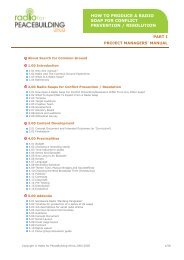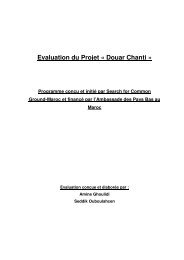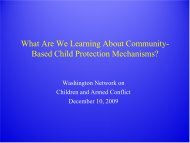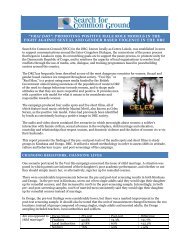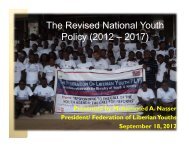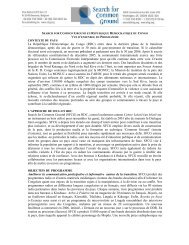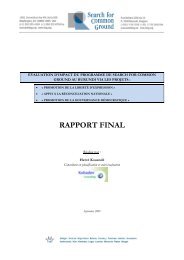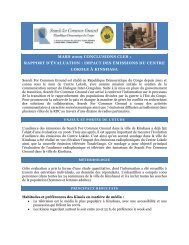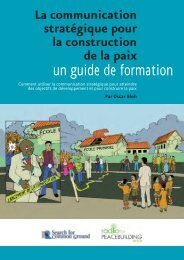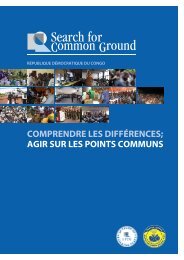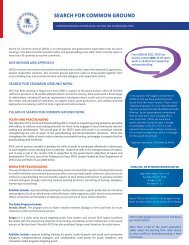notes - Search for Common Ground
notes - Search for Common Ground
notes - Search for Common Ground
You also want an ePaper? Increase the reach of your titles
YUMPU automatically turns print PDFs into web optimized ePapers that Google loves.
Co-Sponsored by<br />
Meeting Notes <strong>for</strong><br />
Youth to Youth: Measuring Youth Engagement in Liberia<br />
18 September 2012<br />
10AM-12PM<br />
<strong>Search</strong> <strong>for</strong> <strong>Common</strong> <strong>Ground</strong><br />
1601 Connecticut Ave, Suite 200<br />
Washington, DC 20009<br />
Overview:<br />
The Washington Network on Children and Armed Conflict (WNCAC) met on 18 September<br />
2012 with a focus on recent, groundbreaking research conducted in Liberia. The session shared<br />
insights into the findings of the research, which sought to listen to the expressed hopes, concerns,<br />
needs and wants of youth in Liberia, and the ways in which the international community might<br />
engage Liberian youth more effectively <strong>for</strong> the peaceful development of the country.<br />
In March 2012, <strong>Search</strong> <strong>for</strong> <strong>Common</strong> <strong>Ground</strong> in collaboration with American University, the<br />
Federation of Liberian Youth, the Ministry of Youth and Sport in Liberia, and the Liberia<br />
Institute of Statistics and Geo In<strong>for</strong>mation Services, conducted a comprehensive study on the<br />
state of youth in Liberia: the concerns, wants, needs and hopes. The study also sought to<br />
compare international donor priorities with the expressed concerns of young Liberians.<br />
Qualitative interviews were supplemented with quantitative mapping of aid flows and analysis of<br />
a multitude of engagement, development and well-being indicators. Two of the researchers,<br />
Celeste Visser and Tom Brownlee, presented on the research process, their experiences, and the<br />
findings. Special guest Mohammed Nasser, President of the Federation of Liberian Youth,<br />
presented on Liberian national policy <strong>for</strong> youth engagement and outlined his vision <strong>for</strong> the role<br />
of youth in Liberia.<br />
Speakers:<br />
Mohammed A. Nasser is the President of the Federation of Liberian Youth (FLY), which he<br />
was elected to in January 2012. In this leadership position, Mr. Nasser continues his outstanding<br />
record of working with the youth and student communities of Liberia <strong>for</strong> the past ten years. He<br />
had previously served as the Vice President of the FLY from 2010-2012. Mr. Nasser has ably<br />
<strong>Search</strong> <strong>for</strong> <strong>Common</strong> <strong>Ground</strong><br />
1 | P age
epresented the Federation in and out of the country, and has travelled with the President of the<br />
Republic of Liberia to discuss the state of affairs of Liberian youth and students in other parts of<br />
the world. He holds an M.B.A. in Public Financial Management from the University of Liberia,<br />
a World Bank-sponsored program, and is currently an M.B.A. candidate in International<br />
Relations at the University of Liberia.<br />
Celeste Visser and Tom Brownlee were part of the seven-member research team that conducted<br />
the "Youth to Youth” research in Liberia. Celeste holds a B.S. in Economics with a minor in<br />
Peace Studies from Manhattan College, and an M.A. in International Development/Development<br />
Economics from American University. She has held internship and research positions at the<br />
Inter-American Foundation and the International Institute <strong>for</strong> Impact Evaluation. Tom holds a<br />
B.A. in Mathematics from Boston College and an M.A. in Comparative and Regional Studies<br />
with a focus on Africa and youth issues from American University. Tom has recently interned<br />
with Grassroots Soccer in Cape Town, South Africa, and Youth Advocate Program International<br />
in Washington, D.C. In addition to Celeste and Tom, the "Youth to Youth" research team was<br />
composed of Liat Krawczyk, Kate Krumrei, Cari McCachren, Neha Raval and Amadou<br />
Bakayoko.<br />
Youth to Youth: Measuring Youth Engagement in Liberia<br />
In Northern Uganda, Liberia, and Sierra Leone<br />
Celeste and Tom’s Presentation – Youth to Youth researchers<br />
Please refer to Tom and Celeste’s PowerPoint <strong>for</strong> more details:<br />
http://www.sfcg.org/programmes/childrenandyouth/pdf/WNCAC%20Presentation.pdf<br />
Overview:<br />
This pilot was a youth-led, technically advised process that was initiated by <strong>Search</strong> <strong>for</strong> <strong>Common</strong><br />
<strong>Ground</strong> in partnership with American University, the Ministry of Youth & Sports in Liberia, the<br />
Federation of Liberian Youth, and the Liberian Ministry <strong>for</strong> Statistics and Geo In<strong>for</strong>mation<br />
Services.<br />
Research Question: Are Liberian Youth engaged in their society, and to what extent are their<br />
(perceived and existent) priorities aligned with those of international donor operating in postpeace<br />
accord Liberia?<br />
The methodology was called a Listening and Learning Approach. It employed a mixed methods<br />
approach.<br />
24 youth in Liberia – qualitative research “Listening and Learning”<br />
• Recruit – sat down terms of reference. Used networks.<br />
<strong>Search</strong> <strong>for</strong> <strong>Common</strong> <strong>Ground</strong><br />
2 | P age
• Orientation – 5 days with local research partners to build team morale and ensure<br />
everyone understood the Listening and Learning process.<br />
• Divide 4 teams into 15 counties. Teams – AU and Liberian Researchers<br />
• 2 people going around community. 1 with tape recorder and 1 leading conversation.<br />
• Want natural conversation. What does it mean to be a youth in Liberia? Not leading the<br />
question.<br />
Themes (8 in total but discuss 3 today):<br />
Education:<br />
• There was a dedication to education from youth. Youth would go out of the way to get to<br />
school or get a family member to school.<br />
• Primary schools, but limited high schools around.<br />
• ODA to education<br />
• ODA to education is increasing, government priorities of education increasing<br />
• Disparity of funding going to primary schooling<br />
• Source of frustration <strong>for</strong> youth who had been through primary education<br />
• 2004-2009 literacy rates increased from 71 to 79%<br />
• Story: Small town. Primary, high school and vocational school <strong>for</strong> girls. Went across<br />
river and found majority on other side river were not attending school as they were afraid<br />
of the water.<br />
Livelihood<br />
• Generally ODA funding is increasing<br />
• 1 good sign are the statistics on locally started businesses<br />
• Increased access to employment and vocational training – youth.<br />
• Empower youth to establish own business and Entrepreneur opportunities.<br />
• Knowledge of career tracks needed to do what they want.<br />
• More protection on workers’ rights. Not en<strong>for</strong>ced currently. Scared of being fired if<br />
protest peacefully. (example)<br />
Security:<br />
• Felt country needs more professional police<br />
• Corruption: steps need to be taken to lessen corruption and perceived corruption<br />
• Standards at checkpoints needed. Inconsistent. Simple steps help to increase perception<br />
• Need increased protection of small arms and light weapons<br />
• Need increased protection in security in prisons and conditions<br />
• Refugees left to find land taken or government sold land (land disputes)<br />
<strong>Search</strong> <strong>for</strong> <strong>Common</strong> <strong>Ground</strong><br />
3 | P age
Recommendations:<br />
• Youth engaging Youth and developing, using and incorporating.<br />
• Accountability<br />
• Recommendations on engaging youth to reduce needs of youth<br />
• Encourage mentoring<br />
• Build youth to youth model <strong>for</strong> education building<br />
• Youth were very engaged and impressed in in<strong>for</strong>mal activities. Ways they were<br />
pursuing. Also heard barriers and what marginalized youth were experiencing.<br />
• Donor priorities – yes money is going to areas youth are talking about. But priorities not<br />
matching, and allow youth to be able to speak on priorities<br />
Mohammed A. Nasser – President of FLY<br />
Please refer to PowerPoint <strong>for</strong> more details:<br />
http://www.sfcg.org/programmes/childrenandyouth/pdf/WNCAC%20presentation%20MN.pdf<br />
Fly – established 1974<br />
• Pledge to government of young people nucleus of society and agents of change socially,<br />
economically and politically<br />
• Goal promote youth participation in national decision making<br />
• Responsibilities: Participation, policy, leadership,<br />
• Rights of youth, responsibilities of youth, obligations gov. to youth, obligations of society<br />
to youth<br />
• Loyal to peace security and development<br />
• Be a positive role model<br />
Marginalized youth Targeted:<br />
• Out of school, in school, illiterate<br />
• Unemployed and underemployed youth<br />
• Youth with disabilities<br />
Top 3 themes <strong>for</strong> work<br />
1) Education & Training<br />
2) Employment and Empowerment<br />
3) Sexual Reproductive<br />
Agenda <strong>for</strong> Trans<strong>for</strong>mation Vision 2030 – Fly- issues now to 2030<br />
<strong>Search</strong> <strong>for</strong> <strong>Common</strong> <strong>Ground</strong><br />
4 | P age
• Natural resources, Language, Oil, Corruption, National Identity, Reconciliation<br />
• Increase employment if have skills training programs <strong>for</strong> young people.<br />
• Workshops – content development. What can we do to make leaders accountable? Press<br />
on issues, give evidence and proof.<br />
• Participation leads to ownership/Ownership leads to stability<br />
Q & A<br />
Q) Situation <strong>for</strong> rule of law in strengthening youth, few programs <strong>for</strong> youth and rule of law and<br />
addressing areas of security. Research indicators show that the government en<strong>for</strong>cement of rule<br />
of law is poor.<br />
• Large improvements are needed and it ties into police corruption and prisons. Room <strong>for</strong><br />
improvement and they have a role in assisting. Team with organizations. To build<br />
capacity and knowing what next step is. Huge step in more youth involvement with<br />
video and posters and letting youth know there is more opportunity. The barrier <strong>for</strong> many<br />
is not knowing.<br />
• Create awareness of rights, because once know rights they are empowered.<br />
AWARENESS is key.<br />
Q) Relevant ministries implementing action plans. How can ministries promote resources<br />
through action plans?<br />
Consultation with counties where policies are not passed. Government does a lot when it comes<br />
to policy, but need to adopt and act on these policies. Not just be a story and discussion. An Act<br />
would just be a 3 page critical issues vs. policy 100 plus pages.<br />
Q) Youth Organizations – What is the Criteria to belong?<br />
• Open <strong>for</strong> everyone – Are there orgs that are illiterate that are marginalized.<br />
Q) What about youth leaders separate from FLY?<br />
• As youth leaders they feel disconnected and hopefully able to see more opportunities.<br />
Working to restructure chapters and have elections help build those opportunities and fill<br />
in gaps.<br />
Q) Another challenge is talking to communities and organizations (dialogue going both<br />
directions). Many youth and community members are open to going to youth meetings.<br />
However there is a disconnect where others are not united. Some state stating “What Meeting?”<br />
Reaching more than just reaching educated males who speak loudest seems to be an issue.<br />
<strong>Search</strong> <strong>for</strong> <strong>Common</strong> <strong>Ground</strong><br />
5 | P age
• Utilizing SMS, radio, and other <strong>for</strong>ms of communication to reach rural and marginalized<br />
areas. Areas that may have high illiteracy rates.<br />
Comment: There are lots of critical issues and we are only highlighting a few critical issues. –<br />
Education, Employment,<br />
Q) Youth employment and livelihood – There have been a lot of programs with livelihood and<br />
many of these plans of implementation are too short. Example: 2011 tried to a vacation<br />
employment, the government didn’t pay in time and lots of riots broke out. Are there<br />
suggestions in how employment and livelihood programs can be improved?<br />
• A suggestion is to complete a situational analysis prior to implementation to find where<br />
youth want to work. Example: If youth don’t want to be tailors, then don’t train in this<br />
field. Also, what access to employment is available within that area? What will help<br />
better the society as a whole?<br />
• Donors – only want to learn what they already know and they are not thinking outside<br />
box. There needs to be a conversation with youth and the private sector. There are<br />
complaints about hiring outside. However, there could be training of youth <strong>for</strong> more jobs<br />
that are right there in their communities.<br />
• A Situation analysis would seek out the gaps happening between youth and donor<br />
agencies. Help to get true ideas of positive and long lasting solutions.<br />
Comment: Monitoring is obvious but necessary and is not being implemented.<br />
• There are vast gaps in actual work and results. For youth there is a gap in linking what<br />
they have learned to market and accompanying to starting in these positions.<br />
• Vocational training programs: It is critical that literacy accompanies vocational training.<br />
No complimentary skills, which are needed, are being taught in vocational training<br />
programs.<br />
• A suggestion is to set youth up with apprenticeships and co-ops and ensure challenges are<br />
met. This is not happening as most people are concerned with right now and not the long<br />
term effects of this process.<br />
Q) Unemployment is 60% to 70%. What is role of civil society in this process? Are we raising<br />
expectations and failing?<br />
• Incorporating relationships in bridging gap of private sector and youth training is needed.<br />
Filter in capturing needs. Making sure they have skills, not just entry level skills but<br />
skills to help them build upon towards a career path.<br />
• Having a realistic discussion with youth. Not all youth are going to get perfect jobs.<br />
How can we encourage them to relate more to them and be an active part of society?<br />
Encouraging support <strong>for</strong> programs that are working. Example: Training in classroom vs.<br />
programs with hands on experience. Help government funding go in the right direction..<br />
<strong>Search</strong> <strong>for</strong> <strong>Common</strong> <strong>Ground</strong><br />
6 | P age
Comment: Engaging youth<br />
• Radio is best way to reach youth. Give opportunity to socialize and exchange.<br />
• Taking students from one area to another, to help them better understand what is really<br />
happening in their country. This helps them engage with others, but this is not happening.<br />
Activities to allow them to socialize between different marginalized groups such as<br />
different games allows <strong>for</strong> them to have fun, while learning and these things are not<br />
happening.<br />
• Building community programs with radio is useful. SMS messages don’t work <strong>for</strong> all<br />
areas with lack of cell phones and towers, and also the fact that it is only sending out<br />
messages and does not allow <strong>for</strong> a dialogue.<br />
• More contact is needed. Several Liberian researchers who went to rural areas commented<br />
on how they were experiencing Liberia <strong>for</strong> first time. They didn’t know people lived like<br />
this, didn’t know this was a problem. Every team was shocked with their encounters.<br />
Guest involved in social work: Going where the client is – in<strong>for</strong>mal collectives – car wash, or<br />
in<strong>for</strong>mal commune – leadership present, teamwork, firming up ties, and mentor youth led<br />
organization. Gives them a sense of pride and possibility of what could be.<br />
Exchange ideas or events:<br />
(Commercial and missed a large part of this discussion)<br />
Entrepreneurship training in Liberia: Guest interested in comment on where the clients are and<br />
learning more <strong>for</strong> this project.<br />
October 10 th and 12 th<br />
The PowerPoint presentation used <strong>for</strong> this meeting is available at:<br />
http://www.sfcg.org/programmes/childrenandyouth/pdf/WNCAC%20Presentation.pdf and<br />
http://www.sfcg.org/programmes/childrenandyouth/pdf/WNCAC%20presentation%20MN.pdf.<br />
These <strong>notes</strong> were compiled by Shanna Todd and Caroline Brazill and edited by Jonathan White,<br />
Saji Prelis and John Williamson<br />
<strong>Search</strong> <strong>for</strong> <strong>Common</strong> <strong>Ground</strong><br />
7 | P age



